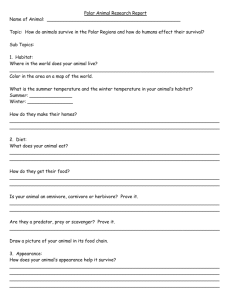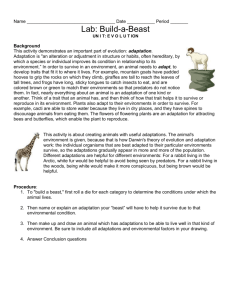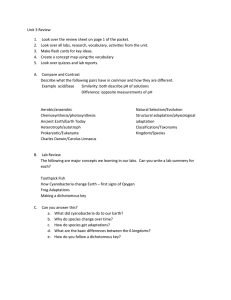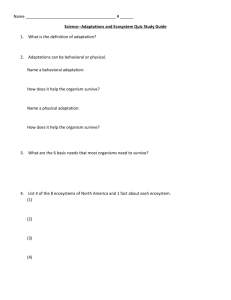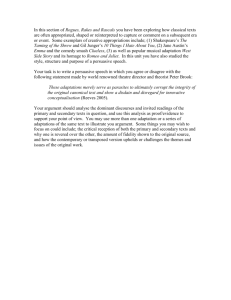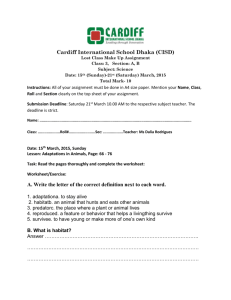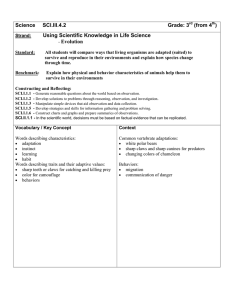Science SCI.III.4.2 Grade: 2
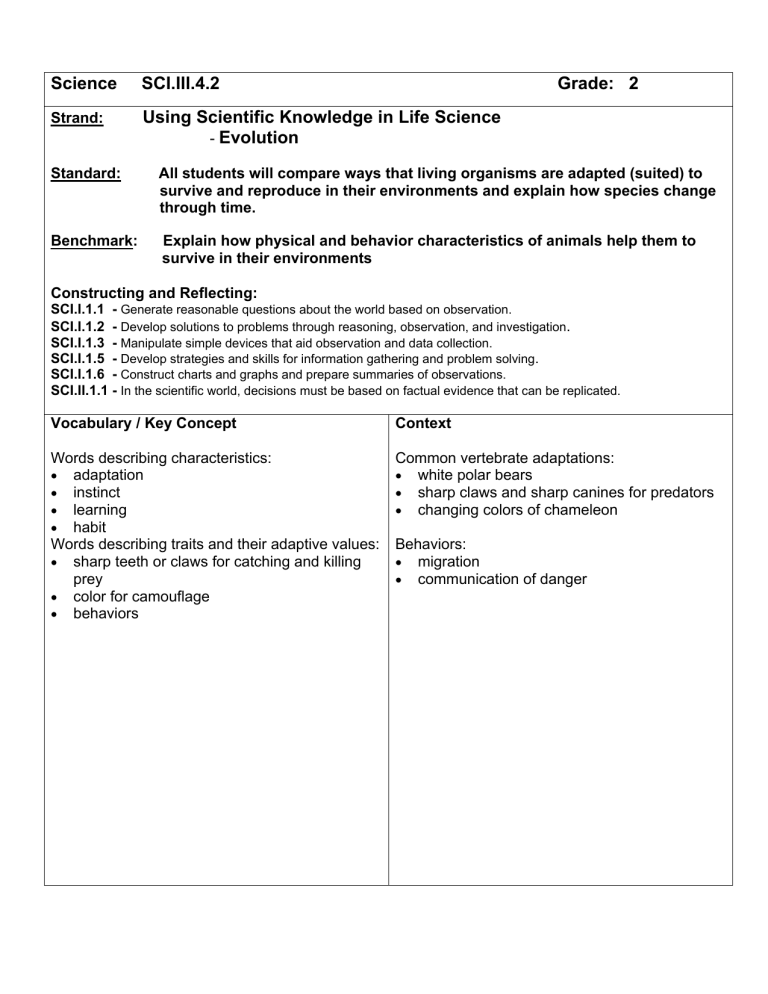
Science SCI.III.4.2 Grade: 2
Strand:
Using Scientific Knowledge in Life Science
-
Evolution
Standard: All students will compare ways that living organisms are adapted (suited) to
survive and reproduce in their environments and explain how species change
through time.
Benchmark: Explain how physical and behavior characteristics of animals help them to
survive in their environments
Constructing and Reflecting:
SCI.I.1.1 - Generate reasonable questions about the world based on observation.
SCI.I.1.2 - Develop solutions to problems through reasoning, observation, and investigation .
SCI.I.1.3 - Manipulate simple devices that aid observation and data collection.
SCI.I.1.5 - Develop strategies and skills for information gathering and problem solving .
SCI.I.1.6 - Construct charts and graphs and prepare summaries of observations.
SCI.II.1.1 - In the scientific world, decisions must be based on factual evidence that can be replicated.
•
•
Vocabulary / Key Concept
Words describing characteristics:
• adaptation
•
• instinct learning
• habit
Words describing traits and their adaptive values:
• sharp teeth or claws for catching and killing prey color for camouflage behaviors
Context
Common vertebrate adaptations:
• white polar bears
•
• sharp claws and sharp canines for predators changing colors of chameleon
Behaviors:
• migration
• communication of danger
Knowledge and Skills
Animals have physical and behavioral characteristics (adaptations) that help them survive. Students will list body parts and behaviors of an animal and interpret how these help it survive in its living area (environment).
Students will:
•
Explain the physical adaptation of owls — they have talons to catch small animals
•
Explain the behavioral adaptation of bears —
•
• they learn to forage in state parks or dumps
Explain the instinct adaptation of salmon — they swim upstream to mate
Explain the physical adaptation of plants — they grow toward a light source
Resources
Coloma Resources:
Newbridge Early Science Program:
“The Big Bears” Teaching Manual and Big Book
“Animals in Hiding” Teacher’s Manual and Big
Book
“The World of Dinosaurs” Pgs 6 & & (Teacher’s
Manual) Diorama pg 13)
Robins - book
Diggins - book
Play Dough - experiment
Cups – goes with above experiment
Fossil Collection - book
Creepy Crawlies - book
Fossil Kit
Mix Up Chameleon - book
Quicktime video – What sounds do Animals
Make? – meshes nicely with the OwlCam sound clips - http://www.teachersdomain.org/3-
5/sci/life/colt/sound/index.html
Teacher Domain – Characteristics of Living
Things – lots of clips and images of various animals and adaptations! AWESOME - http://www.teachersdomain.org/3-
5/sci/life/colt/index.html
Instruction
Benchmark Question: In what ways are living things adapted (suited) to survive in their environments?
Focus Question: How does an animal’s camouflage affect its survival?
Divide the class into small groups. Using four different colors of construction paper, prepare a set of 12 fish of each color (48 fish in all) for each group.
One set of 12 fish must be the same blue as the blue paper ‘water’ habitat. In turn, each child in the group uses one hand to pick up (“catch”) as many fish as possible in 10 seconds. All results are charted.
Compile total class data. Through class discussion of the data, respond to the focus question.
(fish shape example)
Assessment
Each student will invent an animal and design an environment (2D or 3D) that will support the invented animal. Develop and explain three physical adaptations and one behavioral adaptation that the animal uses to survive in the environment. Present the model in class with a two-minute presentation.
(Give students the rubric before the activity.)
SCORING RUBRIC
Criteria: Design of environment
Apprentice- Designs (with teacher support) an environment that partially camouflages the animal.
Basic - Designs (with teacher support) an environment that camouflages the animal.
Meets - Designs (without teacher support) an environment that camouflages the animal.
Exceeds - Designs (without teacher support) an environment that camouflages the animal in more than one way.
Criteria: Design of physical adaptations
Apprentice- Designs one or two physical adaptations.
Basic - Designs three physical adaptations.
Meets - Designs and explains three physical adaptations.
Exceeds - Designs and explains more than three physical adaptations.
Criteria: Explanation of behavioral adaptations
Apprentice- Explains a behavioral adaptation.
Basic - Develops a behavioral adaptation.
Meets - Develops and explains one behavioral adaptation.
Exceeds - Compares behavioral adaptation to real animals. Criteria: Effectiveness of oral presentation
Apprentice- Gives an oral presentation with teacher support.
Basic - Gives a two-minute oral presentation with organized information and teacher support.
Meets - Gives a two-minute oral presentation with organized information.
Exceeds - Gives a two-minute oral presentation with eye contact, appropriate volume, good posture, and organized information.
Teacher Notes:
Compare ways that living organisms are adapted to survive and reproduce in their environments and explain how species change through time.
Students need to understand the key components of natural selection. Variation in heritable traits can give some organisms within a species a distinct advantage over others. This variation is derived from new gene combinations or mutations. If a trait, such as sharp claws or teeth for capturing prey, or coloration for camouflage, gives an organism an advantage to survive and reproduce, those advantageous traits will be passed on to it's offspring. The advantaged offspring, in turn, are more likely to survive and reproduce. The frequency of the advantageous trait will therefore increase in the population. Some traits may give no selective advantage or disadvantage to an organism in a particular environment. If the environment changes, however, a particular trait may become advantageous. The environment may also change enough that only a few or possibly no organisms have the traits necessary for survival and the species will then become extinct.
It is important for students to understand the level at which adaptation takes place. Students should understand that organisms cannot willfully change to better fit the environment and pass those changes on to offspring. This involves a common language use of the word adapt, not a biological definition. A Lamarckian vs. a Darwinian explanation of the mechanism for change in the evolution of a giraffe's neck is a good example for students to distinguish the different levels of adaptation first proposed. Students should begin to understand that while natural selection acts on the individual, the resulting adaptation is at the population level.
To further student understanding on adaptation, examples of antibiotic and pesticide resistance can be studied.
Students should be given the opportunity to reflect on and construct their understanding of patterns of change, relatedness of organisms alive today and to those of the past. The scientifically literate student's understanding of evolution and the proposed mechanisms, which account for its occurrence should clearly exhibit the process and nature of science.


